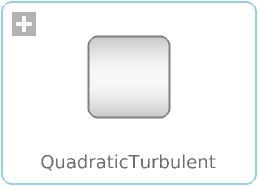WOLFRAM SYSTEM MODELER
QuadraticTurbulentPressure loss components that are mainly defined by a quadratic turbulent regime with constant loss factor data |
|
Package Contents
|
Data structure defining constant loss factor data for dp = zeta*rho*v*|v|/2 and functions providing the data for some loss types |
|
|
Return mass flow rate from constant loss factor data and pressure drop (m_flow = f(dp)) |
|
|
Return mass flow rate from constant loss factor data, pressure drop and Re (m_flow = f(dp)) |
|
|
Return pressure drop from constant loss factor and mass flow rate (dp = f(m_flow)) |
|
|
Return pressure drop from constant loss factor, mass flow rate and Re (dp = f(m_flow)) |
|
|
Generic pressure drop component with constant turbulent loss factor data and without an icon |
|
|
BaseModelNonconstantCrossSectionArea Generic pressure drop component with constant turbulent loss factor data and without an icon, for non-constant cross section area |
|
|
pressureLoss_m_flow_totalPressure Return pressure drop from constant loss factor and mass flow rate (dp = f(m_flow)) |
Information
This information is part of the Modelica Standard Library maintained by the Modelica Association.
This library provides pressure loss factors of a pipe segment (orifice, bending etc.) with a minimum amount of data. If available, data can be provided for both flow directions, i.e., flow from port_a to port_b and from port_b to port_a, as well as for the laminar and the turbulent region. It is also an option to provide the loss factor only for the turbulent region for a flow from port_a to port_b. Basically, the pressure drop is defined by the following equation:
Δp = 0.5*ζ*ρ*v*|v| = 0.5*ζ/A^2 * (1/ρ) * m_flow*|m_flow| = 8*ζ/(π^2*D^4*ρ) * m_flow*|m_flow|
where
- Δp is the pressure drop: Δp = port_a.p - port_b.p
- v is the mean velocity.
- ρ is the density.
- ζ is the loss factor that depends on the geometry of the pipe. In the turbulent flow regime, it is assumed that ζ is constant and is given by "zeta1" and "zeta2" depending on the flow direction.
- D is the diameter of the pipe segment. If this is not a circular cross section, D = 4*A/P, where A is the cross section area and P is the wetted perimeter.
Wolfram Language

SystemModel["Modelica.Fluid.Fittings.BaseClasses.QuadraticTurbulent"]

